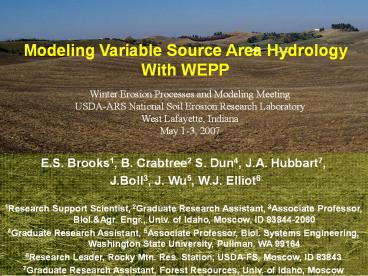Modeling Variable Source Area Hydrology With WEPP - PowerPoint PPT Presentation
Title:
Modeling Variable Source Area Hydrology With WEPP
Description:
Modeling Variable Source Area Hydrology With WEPP Winter Erosion Processes and Modeling Meeting USDA-ARS National Soil Erosion Research Laboratory – PowerPoint PPT presentation
Number of Views:179
Avg rating:3.0/5.0
Title: Modeling Variable Source Area Hydrology With WEPP
1
Modeling Variable Source Area Hydrology With WEPP
Winter Erosion Processes and Modeling
Meeting USDA-ARS National Soil Erosion Research
Laboratory West Lafayette, Indiana May 1-3, 2007
E.S. Brooks1, B. Crabtree2 S. Dun4, J.A.
Hubbart7, J.Boll3, J. Wu5, W.J.
Elliot6 1Research Support Scientist, 2Graduate
Research Assistant, 3Associate Professor,
Biol.Agr. Engr., Univ. of Idaho, Moscow, ID
83844-2060 4Graduate Research Assistant,
5Associate Professor, Biol. Systems Engineering,
Washington State University, Pullman, WA
99164 6Research Leader, Rocky Mtn. Res. Station,
USDA-FS, Moscow, ID 83843 7Graduate Research
Assistant, Forest Resources, Univ. of Idaho,
Moscow
2
Research Direction
- Evaluation of conservation practices in 10-100
km2 watersheds (USDA-CEAP) - Assessing the cumulative effects of land
management practices on sediment loading at the
watershed outlet - Both Ag. and Forested watersheds (Paradise Creek
and Mica Creek watersheds)
3
Variable Source Area Hydrology
- Runoff producing areas are directly related to
the local soil water storage capacity (i.e.
saturation excess runoff) - Extent varies by season, event
- Where is it important?
- Shallow soils (i.e. perched WTs)
- Steep converging slopes (e.g. toe slopes)
- Low intensity rainfall and/or snowmelt
4
In VSA Hydrology, Steeper slopes generate less
runoff, than flat slopes
Water Balance with lateral flow (2-Dim Flow)
5
Lateral Flow Drives Spatial Variability
3 Dim Flow
Soil Saturation and runoff in converging zones
High lateral flow, minimal runoff In steep,
diverging areas
6
Perched Water Tables
STATSGO
7
(No Transcript)
8
VSA Hydrology in WEPP
- Lateral flow is calculated in WEPP by OFE
- Convergence of lateral flow along a hillslope can
only be simulated in WEPP with multiple OFEs - Convergence of lateral flow drives the
distribution of VSA runoff on a hillslope
9
Single Hillslope Lateral flow, Runoff, Erosion
and Deposition
Small lateral flow at the outlet does not mean
lateral flow is not important!!
10
Paradise Creek Watershed
- 28 km2 (AgForest)
- WW-SG-Legume
- - 556 Hillslopes
- - Up to 19 OFEs on each hillslope
11
Applying WEPP to Large Watersheds
- Use GEOWEPP to generate single OFE slope, soil,
management files, and hillslope/channel structure - Convert single OFE files to multiple OFE files
- Run the program as a batch file
- Extract hillslope output (including percolation)
to generate streamflow
12
Application to Paradise Creek
13
Paradise Creek Watershed
14
Grass
Direct Seed
Mulch Till
Conventional
0.07 Tons/ac 614 Tons
2.5 tons/ac 24,000 tons
0.9 tons/ac 10,000 tons
0.1 tons/ac 1100 tons
Sediment Delivery by Hillslope
Winter Wheat Spring Barley Spring Peas Rotation
30 year Averages
15
Application to Mica Creek
Nested forested watershed Snowmelt Dominated -
2-12 km2 sub-watersheds
16
Soil Moisture Routing Model (Frankenberger et
al., 1999)
17
WEPP Fitted Snowmelt
18
WEPP Simulations
Rain Passes Through Snow pack
19
Simulation on a 39 North Facing Slope
20
Hubbart et al. work in Mica Creek
- Measured variability in snow accumulation
- 2006 peak snow water equivalent
- 57 cm clear cut
- 30 cm partial cut
- 12-22 cm full canopy cover
- Measured variability in snow melt rates
- 1.08 cm/day clear cut
- 0.67 cm/day partial cut
- 0.47 cm/day full canopy
- Persistent Inverse Air Temperature lapse rates
21
Hubbart et al. work in Mica Creek
- Fitting Peak Snow Pack with WEPP
- Simulated effective precipitation
- 875 mm clear cut
- 380 mm partial cut
- 190 mm full canopy cover
- Fitting Snowmelt Rates with WEPP
- Fitted canopy cover
- 55 canopy cover for clear cut
- 73 canopy cover for partial cut
- 81 canopy cover for full canopy
22
WEPP Snowmelt
- Primary limitations in high elevation, forests
- Does not simulate snow pack temperature (i.e.
cold content) - Rain assumed to pass through the snow pack
- Maximum snow density is 350 kg/m3
- Snow settling rates too small
- Over-sensitivity to canopy cover/solar radiation
(i.e. Melt A) - Ignores topographic shading
- Ignores snow interception, sublimation, and
drifting - A daily model applied on an hourly time step
- - Modifications by Hendricks to the US Army
Corps Engineers approach assumed applicable on an
hourly time step
23
Snowmelt Variability with Multiple OFEs
North Facing Slope
24
Snowmelt Variability with Multiple OFEs
South Facing Slope
25
VSA Hydrology Summary
- The spatial distribution of VSA runoff highly
correlated with converging subsurface lateral
flow - Simulation of VSA Hydrology requires multiple
OFEs - Multiple OFEs yield more realistic runoff
distribution maps and hydrograph recessions
26
Snowmelt Recommendations
- Need research on the effects of canopy on
interception, drifting, sublimation - Add in an hourly, physically based approach
- snow pack temperature algorithms
- Improve snow pack density relationships
- Incorporate snow liquid water holding capacity
27
EXTRA SLIDES
28
Snow Water Holding Capacity
- Initial Dec.29th 1996 Snow Pack
- 698 mm SWE, 117 kg/m3 snow density, 6.0 m snow
depth - Next 4 Days 135 mm Rain, 17 mm Snow, No
Snowmelt - Estimated Water Holding Capacity
- (350 kg/m3 117 kg/m3)/1000 6.0 m Snow 1.4 m
- Final Snow Pack
- 698 mm 17 mm 715 mm SWE, 118 kg/m3 snow
density - Assuming all water retained in the snow pack and
no compaction occurs final snow density should be
140 kg/m3 - Assuming 5 WHC then 6980.05 35 mm
- Assuming Tsnow -0.7 then 31 mm
- Total water passing through 135 mm 35 mm 31
mm 69 mm
29
(No Transcript)
30
(No Transcript)
31
Perched Water on a Fragipan soil horizon
Courtesy of Paul McDaniel
32
Single Hillslope Runoff

